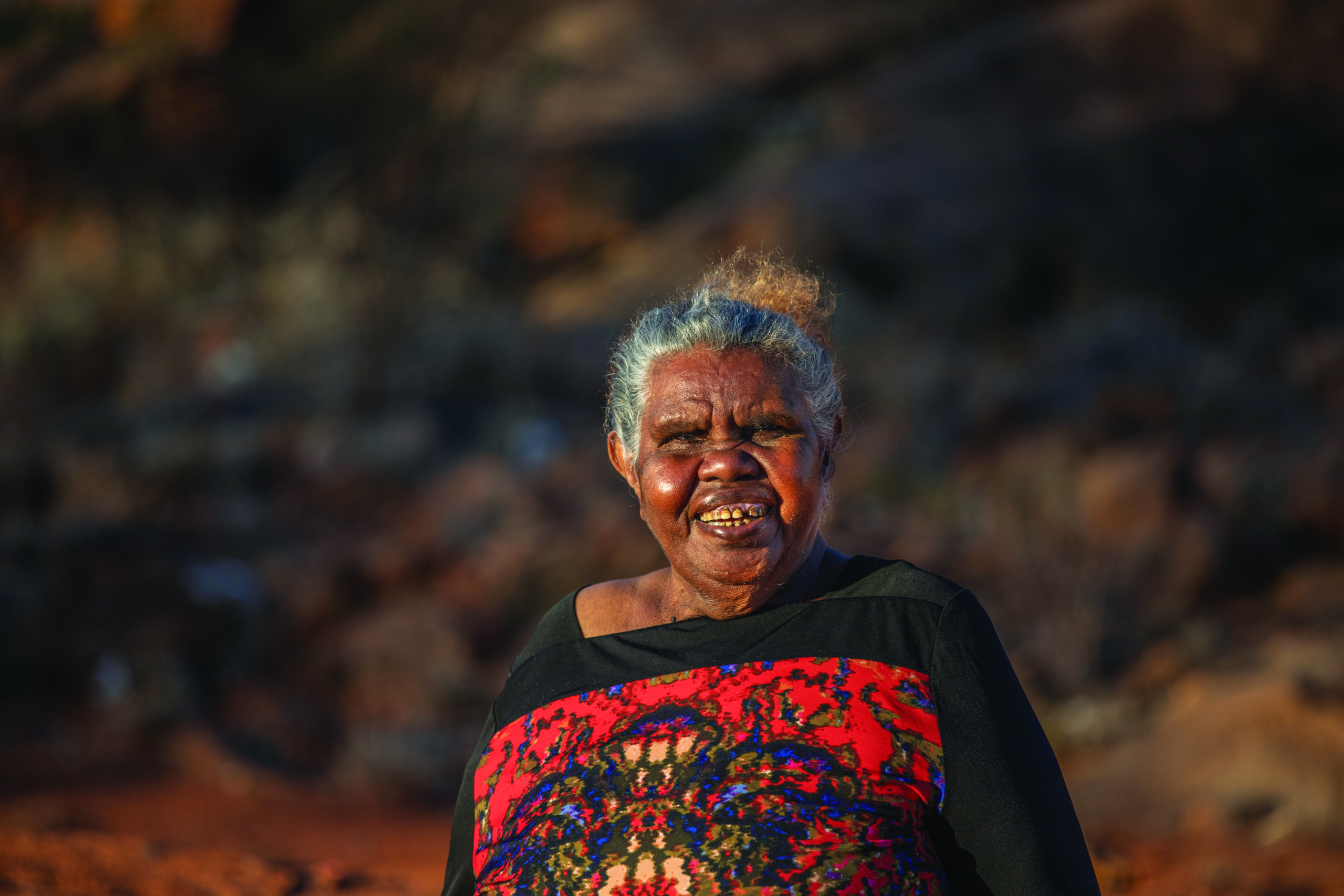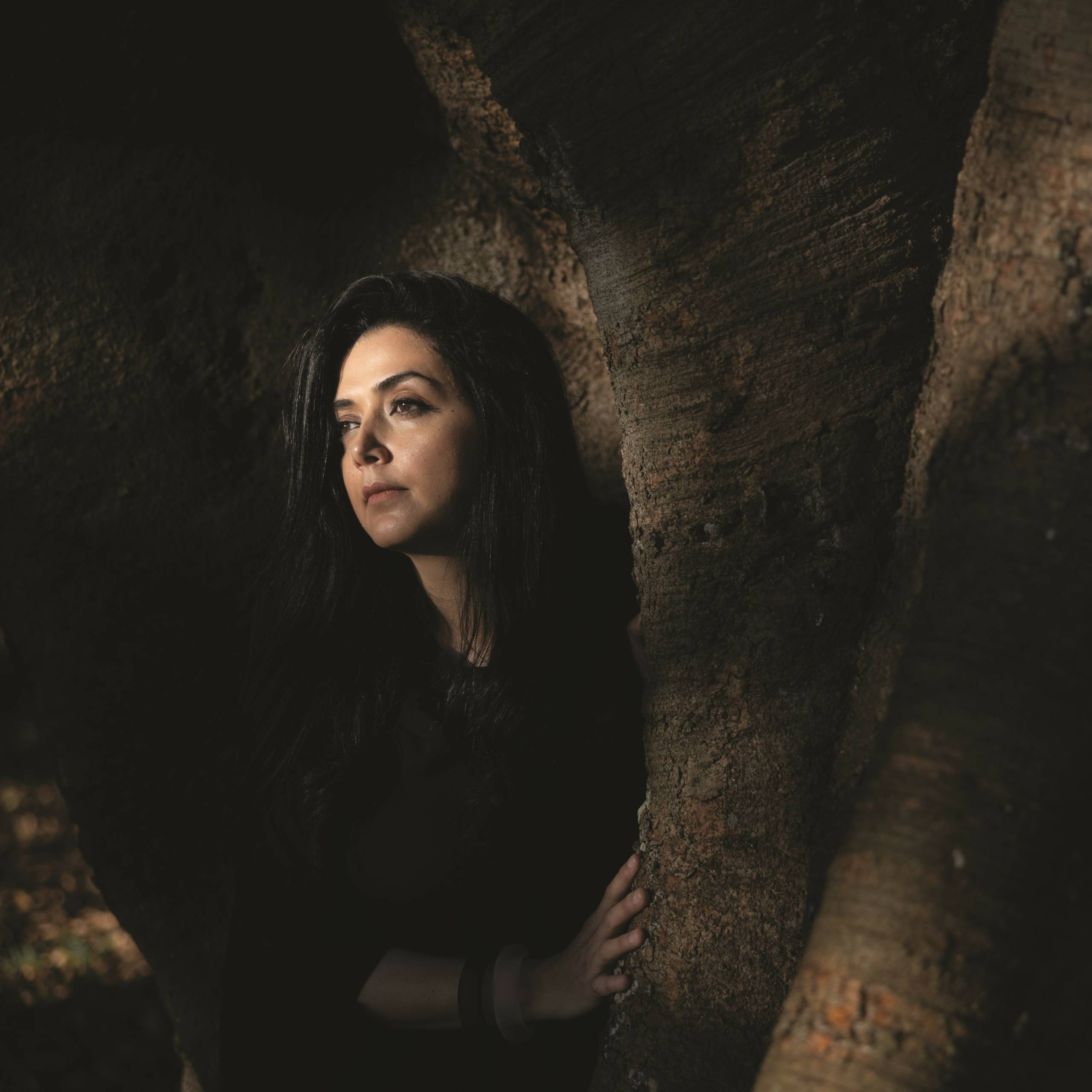Tuppy Ngintja Goodwin: Living Lineage
The works of Tuppy Ngintja Goodwin defy time and geography to provide a contemporary glimpse of her Country.
Words: Tina Baum
Photography: Meg Hansen
For many Aboriginal artists the depiction of Country is a personal expression and a journey of connection, informed either by an intimate unbroken living link or for those living off Country it’s through cultural knowledge handed down through the generations. For Pitjantjatjara senior artisan Tuppy Ngintja Goodwin it is her cultural knowledge and connections to her Country that strongly informs her works. Born near Bumbali Creek, she moved as a young child with her father Nguyarangu from Docker River and mother Emily Nyanyanta from Wintutjuru (west of Kaltjiti/Fregon) and family, to the former cattle station Everard Park, now called Mimili, where she still resides.
An important mentor and senior painter at Mimili Maku Arts since 2009, Ngintja Goodwin’s primary subject for her works centres around the witchetty grub (Endoxyla leucomochla) Tjukurpa or creation story. It is about a ceremonial site out in Country known as Antara and located in the remote Anangu Pitjantjatjara Yankunytjatjara (APY) lands, North-West of South Australia. This special site features three deep main rockholes surrounded by extensive sandhills and winding rocky mountains. These important geological features can be seen in her exquisite works with the rockholes shown as large concentric circles that dominate the aerial compositions. Ngintja Goodwin loads her paintbrush not only with paint but more crucially infuses it with culture, connection and identity that transforms her works through strong, gestural layered strokes. Using her typically soft pastel palette of pinks, white, greens, yellows and reds each works alludes to the surrounding blossoming foliage or the ascending sunrises or sunsets out in Country. Other contrasting paintings featuring darker hues that encapsulate the rockholes with browns and blacks, that possibly hint at the descending depths of the rockholes or of the darkness that settles at this important Tjukurpa or Ancestral site each night.
Other contrasting paintings feature darker hues that encapsulate the rockholes with browns and blacks, that possibly hint at the descending depths of the rockholes or of the darkness that settles at this important Tjukurpa or Ancestral site each night. Her masterful use of colour, line and layered undertones create a shimmer and movement across the canvas and enliven each work
while highlighting the interconnecting pathways taken by the Ancestors. Today, the Community women reinforce their ongoing connection to Antara through big inma/ceremony and subsequent feastings. Although referencing a immemorial Ancestral story, Ngintja Goodwin’s works defy time and geography, providing a contemporary detailed glimpse into hers, her Ancestors and future generations ongoing connection to and knowledge of their Country.
As a key cultural custodian for this important site, she reinforces her connection each time she paints it and leaves an incredible visual legacy and important strong cultural record. Coupled with her dedicated 30 plus years working as a pre-school teacher until her retirement in 2009, her art has provided further opportunities to teach her cultural knowledge with the kids, the next generations through inma (dance and song) and storytelling. As the chairperson of Mimili Maku Arts she leads and continues to make meaningful impacts on her Community and the Indigenous and national arts landscape by proudly showcasing her Pitjantjatjara culture.
A nationally awarded artist, winning the $100,000 acquisitive Australian landscape prize Hadley’s Art Prize in 2022 and this year the $50,000 acquisitive Musselbrook Art Prize, her mastery as an artist and cultural custodian is sure to be celebrated well into the future.
DR MARY KNIGHTS – Senior Curator of Art, Tasmanian Museum and Art Gallery:
“One of the marvellous aspects of being a judge in the Hadley’s Art Prize is scoping the diverse ways that artists engage with landscape. [In 2022] more than 700 Australian artists submitted applications and their styles, media and the conceptual underpinning of their artworks varied enormously.
Narrowing down to a shortlist was a difficult task – but for me Tuppy Ngintja Goodwin’s painting titled Antara stood-out from the beginning.
Tuppy is a senior Pitjantjatjara artist who lives and works at Mimili. Her painting Antara is aesthetically powerful, with a rich colour palette, a bold composition and raw energetic brushstrokes.
It has great cultural integrity and brings together the artist’s deep knowledge of her country, ancient tjukurpa and iconography with western art materials.”
KATRINA ARENT – General Manager, Olsen Gallery, Sydney:
“We showed Tuppy’s work in our first exhibition in association with Anangu Pitjantjatjara Yankunytjatjara (APYlands) back in 2018; a group exhibition titled Nganampa Ngura Kurunjara. Our clients were immediately taken with the muted palette that Tuppy employs to convey the stories of her land, using colours not generally associated with First Nations art making; buttery lemons, lilac and sky blue. I think this is what draws me to her work, while the mark making is rooted in tradition, the palette is playful and has a contemporary appeal.
Tuppy’s works have always been very affordable and even after winning the 2022 Hadley’s Art Prize we have decided to keep them within reach of new collectors. I would estimate that they have gone up about 20% from the first show with prices for a 152 x 122cm canvas at $9,000 and larger works 200 x 183cm at $15,000.
We find the clients that are attracted to Tuppy’s paintings have not considered collecting indigenous work before but are taken with the energy and rigour in her painting style coupled with the delicate marks that tell the stories of her land.”
This article was originally published in Art Collector issue 104, April – July 2023.











